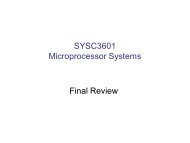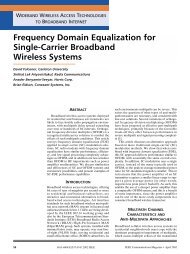Image Reconstruction for 3D Lung Imaging - Department of Systems ...
Image Reconstruction for 3D Lung Imaging - Department of Systems ...
Image Reconstruction for 3D Lung Imaging - Department of Systems ...
Create successful ePaper yourself
Turn your PDF publications into a flip-book with our unique Google optimized e-Paper software.
Chapter 2<br />
Forward Problem<br />
2.1 Description <strong>of</strong> a Basic EIT System and Experiment<br />
The following two sections describe a prototypical EIT system <strong>for</strong> 2D medical applications.<br />
The remainder <strong>of</strong> chapter 2 along with chapter 3 expand on the components and variations<br />
<strong>of</strong> the prototype system.<br />
2.1.1 Data Collection<br />
A typical EIT system uses a set <strong>of</strong> electrodes attached to the surface <strong>of</strong> the medium being<br />
imaged. One can apply current or voltage to the electrodes and then measure the resulting<br />
voltage or current respectively. In most practical systems an alternating current is applied<br />
to some electrodes and the resulting voltages are measured at the other electrodes. Assume<br />
that ℓ = 16 electrodes have been fixed around the surface <strong>of</strong> the object such as the medium<br />
in figure 2.1. There are many ways to apply current and measure the resulting voltages<br />
Figure 2.1: Typical <strong>Imaging</strong> System with 16 Electrodes attached to the boundary <strong>of</strong> an object<br />
<strong>for</strong> current injection and voltage measurement (from [3]).<br />
which will be discussed in section 2.5.1. With the Adjacent drive pattern [16], current is<br />
applied to an adjacent pair <strong>of</strong> electrodes and the resultant voltages between the remaining<br />
13 adjacent pairs <strong>of</strong> electrodes is measured. The three possible measurements involving<br />
one or both <strong>of</strong> the current injecting electrode are not used. This procedure is repeated<br />
16 times with current injected between successive pairs <strong>of</strong> adjacent electrodes until all 16<br />
possible pairs <strong>of</strong> adjacent electrodes have been used to apply the known current. This is<br />
8





